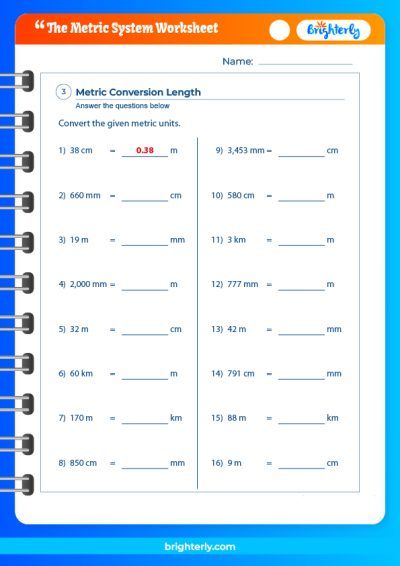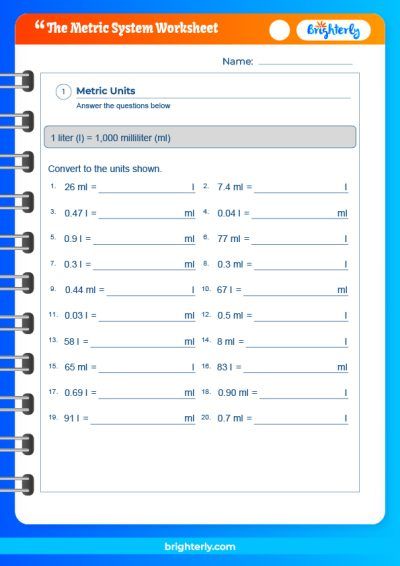Metric System – Definition, Conversions, Examples
Updated on December 13, 2024
Welcome to the in-depth Brighterly introduction to the metric system! The metric system is widely utilized in everyday life, international trade, and scientific study because it is a widely accepted decimal-based method of measurement. Here at Brighterly, we pride ourselves on giving top-notch math worksheets for youngsters to learn and understand the metric system. We will explore many facets of the metric system in this special piece, including its base units, conversions, length, comparison with the imperial system, and much more!
The metric system is a great option for teaching young brains about measures because it provides unmatched uniformity and simplicity. Children may readily comprehend real-world applications and apply their knowledge to a wide range of scientific and daily events by studying the metric system. Brighterly is dedicated to providing interactive resources and kid-friendly content to make learning fun and engaging.
What is the Metric System?
The Metric System is a decimal-based system of measurement extensively used in science, industry, and daily life. This system comprises fundamental units like the meter (for length), kilogram (for mass), and second (for time), along with derived units such as pascal (for pressure), joule (for energy), and watt (for power). The system’s core principle is its reliance on the decimal system, which facilitates conversion and calculation by using powers of ten. This universality and simplicity make the Metric System an essential tool in mathematics, especially in fields requiring precise measurement and standardization.
Metric Units
The metric system has seven base units that serve as the foundation for all other units of measurement. These are:
- Meter (m) – length
- Kilogram (kg) – mass
- Second (s) – time
- Ampere (A) – electric current
- Kelvin (K) – temperature
- Mole (mol) – amount of substance
- Candela (cd) – luminous intensity
These base units can be combined with prefixes to create larger or smaller units. Some common prefixes include:
- Kilo (k) – 1,000
- Hecto (h) – 100
- Deca (da) – 10
- Deci (d) – 0.1
- Centi (c) – 0.01
- Milli (m) – 0.001
- Micro (µ) – 0.000001
- Nano (n) – 0.000000001
Metric System Chart
A metric system chart is a helpful tool for understanding the relationships between different metric units. It can be a table, diagram, or infographic that visually represents the metric units, their prefixes, and their values. A well-designed metric system chart can make it easier for children to grasp the concept of metric measurements and conversions. Here’s a sample metric system chart to help you visualize the relationships between different units.
Metric System Conversion
Converting between metric units is simple, as it only requires multiplying or dividing by powers of ten. This process is called metric system conversion. For example, to convert from kilometers to meters, you multiply by 1,000. To convert from centimeters to meters, you divide by 100. These conversions are essential for various real-life applications, such as calculating distances, weights, and temperatures.
Metric System Length
The base unit of length in the metric system is the meter (m). It is used to measure distances and sizes of objects. To express larger or smaller distances, we use prefixes like kilometers (km), centimeters (cm), and millimeters (mm). Here are some examples:
- 1 kilometer (km) = 1,000 meters (m)
- 1 meter (m) = 100 centimeters (cm)
- 1 meter (m) = 1,000 millimeters (mm)
Metric System vs Imperial
The Imperial system is an older system of measurement that uses units such as inches, feet, yards, and miles for length, and ounces, pounds, and stones for weight. It is still widely used in the United States and a few other countries. Comparing the metric system to the Imperial system, we find that the metric system is much more straightforward and easier to learn, especially for children. The metric system’s base-ten structure simplifies conversions, while the Imperial system involves various conversion factors that can be challenging to memorize.
Solved Examples on Metric System
At Brighterly, we provide the best math worksheets for kids, helping them practice the metric system with ease. Here are some solved examples to help children understand metric system conversions:
-
Convert 5 kilometers to meters:
5 km × 1,000 = 5,000 meters
-
Convert 120 centimeters to meters:
120 cm ÷ 100 = 1.2 meters
-
Convert 7,500 millimeters to meters:
7,500 mm ÷ 1,000 = 7.5 meters
Practice Problems on Metric System
Here are some practice problems for children to work on their metric system skills:
- Convert 3.5 kilometers to meters.
- Convert 450 centimeters to meters.
- Convert 6,200 millimeters to meters.
- Convert 12 kilometers to centimeters.
- Convert 15,000 millimeters to kilometers.
Conclusion on Metric System
In summary, the metric system is a well recognized, practical, and user-friendly method of measuring. Because of its natural uniformity and simplicity, it’s a better option for teaching kids about measures, and Brighterly is dedicated to provide thorough teaching resources to help with the process. Children who become proficient in the metric system have a broader awareness of the world and become more capable of using what they have learned in a variety of scientific and real-world contexts.
At Brighterly, we believe that by equipping young learners with the tools and resources they need to learn the metric system, we are empowering them to excel in various fields, from science and engineering to everyday tasks like cooking and travel planning. The metric system’s logical structure and ease of use pave the way for more efficient problem-solving and streamlined communication in a global context.
Frequently Asked Questions on Metric Systems
What countries do not use the metric system?
The United States, Liberia, and Myanmar are the only three countries that have not fully adopted the metric system as their official system of measurement.
Why is the metric system important?
The metric system is important because it provides a standardized, simple, and consistent method of measurement that is universally recognized. This facilitates global communication, trade, and scientific research.
When was the metric system created?
The metric system was created in France in the late 18th century, during the French Revolution. It was officially adopted by France in 1795.
How do I convert between metric units?
To convert between metric units, you simply multiply or divide by the appropriate power of ten, depending on the prefixes involved. For example, to convert from kilometers to meters, you multiply by 1,000. To convert from centimeters to meters, you divide by 100.
Is the metric system better than the Imperial system?
The metric system is generally considered more straightforward and efficient than the Imperial system due to its decimal-based structure. This makes conversions and calculations much easier to perform and understand.






